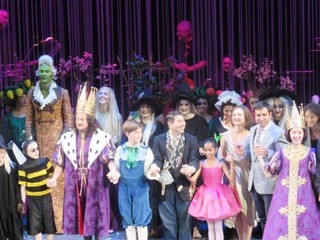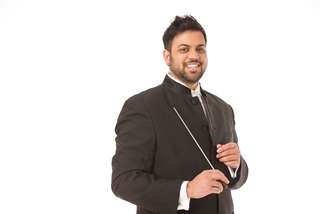|
Back
A Questionable Resurrection Albany
Opera Saratoga, Spa Little Theater, Spa State Park, Saratoga Springs
07/02/2016 - & July 11, 17, 2016
Philip Glass: The Witches of Venice (American Premiere)
Oliver Nathanielsz (Bambino-Plant Boy), Akhila Venket (Bambina-Plant Girl), Dominick Corbacio (The King of Venice), Chanmee Jeong (The Queen of Venice), Emily Spencer (The Maid), Kira Petersen (Wind), Yusaku Komori (Pigeon), Jarrett Porter (The Ogre), Keely Futterer (The Witch Mother), Emelia DeLong, Iris Wiedman, Emily Yocum (Philosophers), Randall Smith (The Chandelier), Dancers from Armitage Gone! Dance
Singers from The Capital District Youth Chorale, Members of Opera Saratoga Young Artist Program (Courtiers, Gondoliers, Fairies of the Lagoon, The Garden, Witches of the Lagoon, Young Witches, Skeletons), Laurie Rogers (Chorus Master), Diante Warner (Children’s Chorus Master), The Opera Saratoga Orchestra Chamber Ensemble, Viswa Subbaraman (Conductor)
Karole Armitage (Director and Choreographer), Caite Hevner (Scenic Designers), Martin T. Lopez (Costume Designer)

Curtain Call Cast (© Samuel A. Dog)
Manhattanites ignorant of Saratoga Opera have much to learn. Those ignorant of Philip Glass’s 21-year-old “children’s ballet-opera” (including this writer) don’t need the usual tar and feathering, but they could still learn that only mediocre composers are always at their best.
But we’ll get to that in a moment.
As to Saratoga Opera, it’s been in existence as a summer festival over half a century now And not with your usual Puccini/Verdi/Carmen repertory, but rare operas and premieres each year from Amram, Argento, Rorem, Wargo and (this year) Catán (his Il postino). The venue is the spacious Spa State Park, presenting everything from Phish (which caused a traffic jam when we were there) to the opera to chamber music, to recitals from luminaries like Renée Fleming.
The operas are in a neo-classic building called “Little Theater”, which, with its capacity for about 800 and splendid acoustics, belies its name. All this within Saratoga Springs, a cynosure for millionaires from the Gilded Age, the inception for the word “Tuxedo” (from a neighboring Native American tribe), and still, a relaxing place to visit.
In fact, it no longer competes in plutocratic splendor with Newport, it is well worth a four-hour bus trip to hear an American premiere for a Philip Glass opera. Truth be told, it was actually a world premiere. The original Le streghe di Venezia was a 1995 commission from La Scala, based on a children’s tale by the late Italian artist Beni Montresor. With only a recording and some photos to go on, Richard Guérin, an associate of Mr. Glass, “resequenced, cut and adapted” the dramaturgy, with the help of the composer. And that was the production shown by Saratoga Opera.
No matter what the revisions, nothing in the The Witches of Venice even approaches the delicacy, humor or naivete of a children’s story or children’s music. The story is frankly overloaded with enough characters to popular a Wagner Ring. We have a boy (who is actually a flower), a girl (ditto), a King and barren Queen of Venice (which never had such titles, but never mind) as well as a Pigeon, a Wind, an Ogre (who eats royalty “and American heiresses), fairies, gondoliers, an endless supply of Lagoon Witches, Young Witches, Skeletons, a Witch Mother, a Bee, three Philosophers, some courtiers and–without a kitchen sink–a live Chandelier.
Nor does the story make much sense. Basically a ballet with some singing, a pre-reading of the synopsis told of multiple kidnappings, the boy who pleads loneliness but wrestles with the witches and ogres, the Wind and Pigeon who take the boy, return him, fly out with him and then return him to the King and Queen (with whom he is doubtless destined to live a nightmarish life).
My companion at the opera didn’t read the synopsis beforehand, for the few Italian lines of singing were translated on the screen. But we were equally confused by the action. The reason is that it moved constantly–through the audience, around the stage, down the aisles–but the movement were without purpose. Nor did this 75-minute composition (the original intermission never ensued) ever possess an iota of either the humor or the Roald Dahl-style mordant humor which kids enjoy so much.
Alright, so the King and Queen summon three philosophers to solve their problem of giving them a baby. The toga-clad children marched in, danced, looked through great tomes, marched out, marched in and out again like philosophical nihilists). The Witches shimmied and shook, exited, returned, shimmied and shook some more, paraded through the audience, were joined with more witches, young witches and skeletons (actually grown-up men looking rather silly coming down the aisles). They were joined by a Witch Mother (with nothing to do), an Ogre (with nice music) and a Chandelier (the less said, the better).
It was, in a work which was corpulent, heavy, sober (with a few paltry jokes) and gaudy. One longed for, perhaps unfairly, Britten’s Noyes Fludde, that children’s opera of gossamer lightness; or Prokofiev’s Peter and the Wolf, where even the cannibalism was worked seamlessly into nature.
To its credit, while the comings and goings approximated cattle-herding, the cast was deliciously colorful. Credit above all Costume Designer Martin T. Lopez for giving each of the 16-odd garden flowers different floral outfits, for giving the enchanting ballet dancer Kira Petersen an all-white angelic costume as the Wind, for turning Jarrett Porter into a green seven-foot-high Ogre, and allowing the rest of the huge cast all the decoration as expensively garish as a children’s book.
Happily too, while the direction was oversaturated with movement, the ballet dancers–half of them children–were graceful, knew their roles and frequently were moving. While Oliver Nathanielsz didn’t have a coherent character, he was sympathetic, could be aggressive (wrestling with Ogre or Witch) or docile (“No one sees me, no one talks to me”), and was a Constant amongst the locomotive. Both Ms. Petersen as Wind and Yusaku Komori as Pigeon, moved with equal balletic grace. The multitude of witches were anything but scary, doing their modern dancing with some kind of improvisatory excitement.

V. Subbaraman
The real credit, though, goes to Conductor Viswa Subbaraman, who, behind a lacy curtain, conducted his six-piece “Opera Saratoga Orchestra Chamber Ensemble”–Flutes, clarinets, cello, percussion and keyboards–with an excitement and accuracy which almost made up for the clunkiness on stage.
This was not great Philip Glass music by any means. We had some colorful sections, like the Ogre music, the song of the Plant Boy, the final chorus. The rest has Glass’s trademark repeated scales, with near-cusps of melodrama, approximations of light humor (the dances of the witches). Yet nothing approaching the sense of Philip Glass intensity or forwardness ever really approached.
It took Mr. Subbaraman’s incisive conducting to offer the volition which the actual music lacked. And I was almost relieved that I saw only a single child in the audience, for children above any adult can spot the dross beneath the fluff.
While Saratoga Opera has two productions remaining, may I humbly suggest to editor Mark Guérin yet another edition of The Witches of Venice? First, cut it in half...or at least two-thirds. If not annihilating the characters, shorten their appearances and disappearances. Second, do away with the voices. Instead, use Prokofiev’s device of a narrator, one who tells exactly what is being danced and why.
One doubts that this will save the work from Philip Glass’s artistic detritus. But after Saratoga, perhaps The Witches of Venice may live to see another day.
Harry Rolnick
|